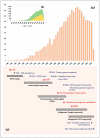Mitochondrial DNA in Human Diversity and Health: From the Golden Age to the Omics Era
- PMID: 37628587
- PMCID: PMC10453943
- DOI: 10.3390/genes14081534
Mitochondrial DNA in Human Diversity and Health: From the Golden Age to the Omics Era
Abstract
Mitochondrial DNA (mtDNA) is a small fraction of our hereditary material. However, this molecule has had an overwhelming presence in scientific research for decades until the arrival of high-throughput studies. Several appealing properties justify the application of mtDNA to understand how human populations are-from a genetic perspective-and how individuals exhibit phenotypes of biomedical importance. Here, I review the basics of mitochondrial studies with a focus on the dawn of the field, analysis methods and the connection between two sides of mitochondrial genetics: anthropological and biomedical. The particularities of mtDNA, with respect to inheritance pattern, evolutionary rate and dependence on the nuclear genome, explain the challenges of associating mtDNA composition and diseases. Finally, I consider the relevance of this single locus in the context of omics research. The present work may serve as a tribute to a tool that has provided important insights into the past and present of humankind.
Keywords: aDNA; aging; diseases; forensics; haplogroup; human population genetics; longevity; mitogenome; phylogeny; phylogeography.
Conflict of interest statement
The author declares no conflict of interest.
Figures


Similar articles
-
Biparental Inheritance of Mitochondrial DNA in Humans.Proc Natl Acad Sci U S A. 2018 Dec 18;115(51):13039-13044. doi: 10.1073/pnas.1810946115. Epub 2018 Nov 26. Proc Natl Acad Sci U S A. 2018. PMID: 30478036 Free PMC article.
-
Demography or selection on linked cultural traits or genes? Investigating the driver of low mtDNA diversity in the sperm whale using complementary mitochondrial and nuclear genome analyses.Mol Ecol. 2018 Jun;27(11):2604-2619. doi: 10.1111/mec.14698. Epub 2018 May 17. Mol Ecol. 2018. PMID: 29675902
-
Resolving mitochondrial haplogroups B2 and B4 with next-generation mitogenome sequencing to distinguish Native American from Asian haplotypes.Forensic Sci Int Genet. 2019 Nov;43:102143. doi: 10.1016/j.fsigen.2019.102143. Epub 2019 Aug 13. Forensic Sci Int Genet. 2019. PMID: 31473588
-
MtDNA: The small workhorse of evolutionary studies.Front Biosci (Landmark Ed). 2017 Jan 1;22(5):873-887. doi: 10.2741/4522. Front Biosci (Landmark Ed). 2017. PMID: 27814652 Review.
-
Atypical mitochondrial inheritance patterns in eukaryotes.Genome. 2015 Oct;58(10):423-31. doi: 10.1139/gen-2015-0090. Epub 2015 Sep 14. Genome. 2015. PMID: 26501689 Review.
Cited by
-
Mitochondrial ancestry from complete mitogenomes highlights a lack of characterization of indigenous haplogroups in Brazilian Amazon population.Commun Biol. 2025 May 30;8(1):835. doi: 10.1038/s42003-025-08126-4. Commun Biol. 2025. PMID: 40447749 Free PMC article.
-
The complete mitochondrial genome of Sinojackia microcarpa: evolutionary insights and gene transfer.BMC Genomics. 2025 May 6;26(1):446. doi: 10.1186/s12864-025-11633-7. BMC Genomics. 2025. PMID: 40329166 Free PMC article.
-
The interplay between mitochondrial DNA genotypes, female infertility, ovarian response, and mutagenesis in oocytes.Hum Reprod Open. 2024 Dec 30;2025(1):hoae074. doi: 10.1093/hropen/hoae074. eCollection 2025. Hum Reprod Open. 2024. PMID: 39830711 Free PMC article.
References
Publication types
MeSH terms
Substances
LinkOut - more resources
Full Text Sources
Miscellaneous

